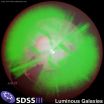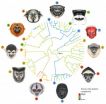(Press-News.org) Using NASA's Hubble Space Telescope, astronomers have solved a longstanding mystery on the type of star, or so-called progenitor, which caused a supernova seen in a nearby galaxy. The finding yields new observational data for pinpointing one of several scenarios that trigger such outbursts.
Based on previous observations from ground-based telescopes, astronomers knew the supernova class, called a Type Ia, created a remnant named SNR 0509-67.5, which lies 170,000 light-years away in the Large Magellanic Cloud galaxy.
Theoretically, this kind of supernova explosion is caused by a star spilling material onto a white dwarf companion, the compact remnant of a normal star, until it sets off one of the most powerful explosions in the universe.
Astronomers failed to find any remnant of the companion star, however, and concluded that the common scenario did not apply in this case, although it is still a viable theory for other Type Ia supernovae.
"We know Hubble has the sensitivity necessary to detect the faintest white dwarf remnants that could have caused such explosions," said lead investigator Bradley Schaefer of Louisiana State University (LSU) in Baton Rouge. "The logic here is the same as the famous quote from Sherlock Holmes: 'when you have eliminated the impossible, whatever remains, however improbable, must be the truth.'"
The cause of SNR 0509-67.5 can be explained best by two tightly orbiting white dwarf stars spiraling closer and closer until they collided and exploded.
For four decades, the search for Type Ia supernovae progenitors has been a key question in astrophysics. The problem has taken on special importance during the last decade with Type Ia supernovae being the premier tools for measuring the accelerating universe.
Type Ia supernovae release tremendous energy, in which the light produced is often brighter than an entire galaxy of stars. The problem has been to identify the type of star system that pushes the white dwarf's mass over the edge and triggers this type of explosion. Many possibilities have been suggested, but most require that a companion star near the exploding white dwarf be left behind after the explosion.
Therefore, a possible way to distinguish between the various progenitor models has been to look deep in the center of an old supernova remnant to search for the ex-companion star.
In 2010, Schaefer and Ashley Pagnotta of LSU were preparing a proposal to look for any faint ex-companion stars in the center of four supernova remnants in the Large Magellanic Cloud when they discovered the Hubble Space Telescope already had taken the desired image of one of their target remnants, SNR 0509-67.5, for the Hubble Heritage program, which collects images of especially photogenic astronomical targets.
In analyzing the central region, they found it to be completely empty of stars down to the limit of the faintest objects Hubble can detect in the photos. Schaefer suggests the best explanation left is the so-called "double degenerate model" in which two white dwarfs collide.
The results are being reported today at the meeting of the American Astronomical Society in Austin, Texas. A paper on the results will be published in the Jan. 12 issue of the journal Nature.
There are no recorded observations of the star exploding. However, researchers at the Space Telescope Science Institute in Baltimore, Md. have identified light from the supernova that was reflected off of interstellar dust, delaying its arrival at Earth by 400 years. This delay, called a light echo of the supernova explosion also allowed the astronomers to measure the spectral signature of the light from the explosion. By virtue of the color signature, astronomers were able to deduce it was a Type Ia supernova.
Because the remnant appears as a nice symmetric shell or bubble, the geometric center can be determined accurately. These properties make SNR 0509-67.5 an ideal target to search for ex-companions. The young age also means that any surviving stars have not moved far from the site of the explosion.
The team plans to look at other supernova remnants in the Large Magellenic Cloud to further test their observations.
INFORMATION:
The Hubble Space Telescope is a project of international cooperation between NASA and the European Space Agency. NASA's Goddard Space Flight Center manages the telescope. The Space Telescope Science Institute (STScI) conducts Hubble science operations. STScI is operated for NASA by the Association of Universities for Research in Astronomy, Inc., in Washington, D.C.
Hubble solves mystery on source of supernova in nearby galaxy
2012-01-13
ELSE PRESS RELEASES FROM THIS DATE:
New information on the waste-disposal units of living cells
2012-01-13
Important new information on one of the most critical protein machines in living cells has been reported by a team of researchers with the U.S. Department of Energy's Lawrence Berkeley National Laboratory (Berkeley Lab) and the University of California (UC) Berkeley. The researchers have provided the most detailed look ever at the "regulatory particle" used by the protein machines known as proteasomes to identify and degrade proteins that have been marked for destruction. The activities controlled by this regulatory particle are critical to the quality control of cellular ...
A clue to the GI problems that plague many kids with autism?
2012-01-13
January 11, 2012 -- New research conducted in the Center for Infection and Immunity (CII) at Columbia University's Mailman School of Public Health, reports that children with autism and gastrointestinal disturbances have high levels of a bacterium called Sutterella in their intestines.
Study findings are published online in the journal mBio.
The investigators found that over half of the children diagnosed with autism and gastrointestinal disturbances had Sutterella in intestinal biopsy tissue, while Sutterella was absent in biopsies from typically developing children ...
Treatment with light benefits Alzheimer's patients, Wayne State University finds
2012-01-13
Detroit - Exposure to light appears to have therapeutic effects on Alzheimer's disease patients, a Wayne State University researcher has found.
In a study published recently in the Western Journal of Nursing Research, LuAnn Nowak Etcher, Ph.D., assistant professor of nursing, reported that patients treated with blue-green light were perceived by their caregivers as having improved global functioning.
Caregivers said patients receiving the treatment seemed more awake and alert, were more verbally competent and showed improved recognition, recollection and motor coordination. ...
Rice's 'quantum critical' theory gets experimental boost
2012-01-13
New evidence this week supports a theory developed five years ago at Rice University to explain the electrical properties of several classes of materials -- including unconventional superconductors -- that have long vexed physicists.
The findings in this week's issue of Nature Materials uphold a theory first offered in 2006 by physicist Qimiao Si, Rice's Harry C. and Olga K. Wiess Professor of Physics and Astronomy. They represent an important step toward the ultimate goal of creating a unified theoretical description of the quantum behavior of high-temperature superconductors ...
ISG15: A novel therapeutic target to slow breast cancer cell motility
2012-01-13
Interferon-stimulated gene 15 (ISG15), a ubiquitin like protein, is highly elevated in a variety of cancers including breast cancer. How the elevated ISG15 pathway contributes to tumorigenic phenotypes remains unclear and is the subject of a study published in the January 2012 issue of Experimental Biology and Medicine. Dr. Shyamal Desai and her co-investigators from the Louisiana State University School of Medicine in New Orleans, the University of Pennsylvania School of Medicine in Philadelphia, and the Robert Wood Johnson School of Medicine in New Jersey report that ...
Calculating what's in the universe from the biggest color 3-D map
2012-01-13
Since 2000, the three Sloan Digital Sky Surveys (SDSS I, II, III) have surveyed well over a quarter of the night sky and produced the biggest color map of the universe in three dimensions ever. Now scientists at the U.S. Department of Energy's Lawrence Berkeley National Laboratory (Berkeley Lab) and their SDSS colleagues, working with DOE's National Energy Research Scientific Computing Center (NERSC) based at Berkeley Lab, have used this visual information for the most accurate calculation yet of how matter clumps together – from a time when the universe was only half its ...
Stenting for stroke prevention becoming safer in high-risk patients
2012-01-13
MADISON –Placing a stent in a key artery in the neck is safer than ever in patients ineligible for the standard surgical treatment of carotid artery disease, according to a new study published online today in the Journal of Vascular Surgery.
A team of researchers led by Dr. Jon Matsumura, head of the vascular surgery division at University of Wisconsin School of Medicine and Public Health, found the clinical trial PROTECT (Carotid Artery Stenting with Distal Embolic Protection with Improved System) had the lowest rate of complications ever in patients considered high ...
Evolution is written all over your face
2012-01-13
Why are the faces of primates so dramatically different from one another?
UCLA biologists working as "evolutionary detectives" studied the faces of 129 adult male primates from Central and South America, and they offer some answers in research published today, Jan. 11, in the early online edition of the journal Proceedings of the Royal Society B. The faces they studied evolved over at least 24 million years, they report.
"If you look at New World primates, you're immediately struck by the rich diversity of faces," said Michael Alfaro, a UCLA associate professor ...
UMass Amherst chemical engineers boost petrochemical output from biomass by 40 percent
2012-01-13
AMHERST, Mass. – Chemical engineers at the University of Massachusetts Amherst, using a catalytic fast pyrolysis process that transforms renewable non-food biomass into petrochemicals, have developed a new catalyst that boosts the yield for five key "building blocks of the chemical industry" by 40 percent compared to previous methods. This sustainable production process, which holds the promise of being competitive and compatible with the current petroleum refinery infrastructure, has been tested and proven in a laboratory reactor, using wood as the feedstock, the research ...
Hubble breaks new ground with discovery of distant exploding star
2012-01-13
NASA's Hubble Space Telescope has looked deep into the distant universe and detected the feeble glow of a star that exploded more than 9 billion years ago. The sighting is the first finding of an ambitious survey that will help astronomers place better constraints on the nature of dark energy, the mysterious repulsive force that is causing the universe to fly apart ever faster.
"For decades, astronomers have harnessed the power of Hubble to unravel the mysteries of the universe," said John Grunsfeld, associate administrator for NASA's Science Mission Directorate in Washington. ...




